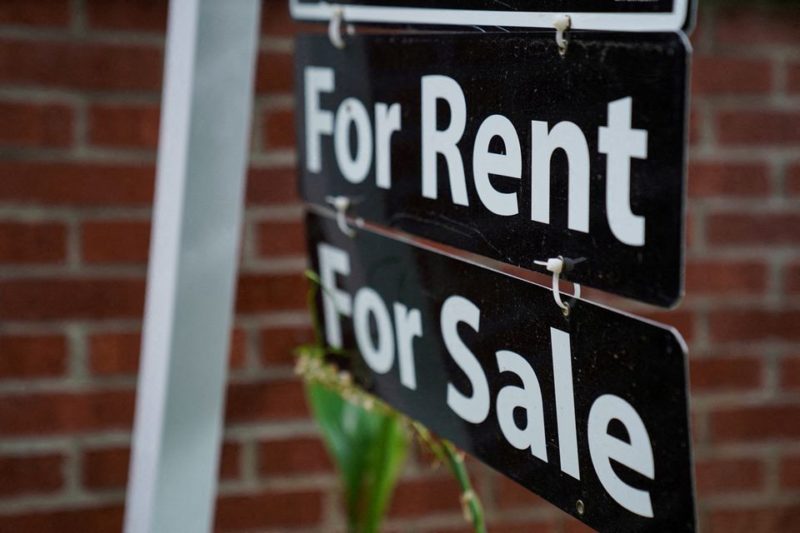U.S. single-family homebuilding rebounded in September, boosted by demand for new construction amid an acute housing shortage, but the highest mortgage rates in nearly 23 years could slow momentum and delay the overall housing market recovery.
That was flagged by other data on Wednesday showing applications for loans to purchase a home plunged last week to levels last seen in 1995. In addition, the jump in housing starts partially recouped the decline in August.
The rebound in homebuilding probably reflected permits approved several months ago before mortgage rates broke above 7%. A survey this week showed confidence among single-family homebuilders slumped to a nine-month low in October, with builders reporting lower levels of traffic.
"In the very short-term, single-family construction activity is likely to increase with permits rising in every month of 2023 thus far, but at some point mortgage rates are likely to put a lid on new construction activity for home purchase," said Conrad DeQuadros, senior economic advisor at Brean Capital in New York.
Single-family housing starts, which account for the bulk of homebuilding, increased 3.2% to a seasonally adjusted annual rate of 963,000 units last month, the Commerce Department said. Data for August was revised to show starts dropping to a rate of 933,000 units instead of 941,000 units as previously reported.
Single-family starts rose in the Midwest, West and the densely populated South, but plunged 19.0% in the Northeast.
The housing market had shown signs of stabilizing before mortgage rates resumed their upward trend late in the summer, with the rate on the popular 30-year fixed mortgage vaulting above 7% in August. According to the Mortgage Bankers Association, the average contract interest rate on a 30-year fixed-rate mortgage rose 3 basis points to 7.70% last week, the highest since November 2000.
Mortgage rates have risen in tandem with the yield on the benchmark 10-year Treasury note, which has spiked to more than a 16-year high, mostly because of expectations that the Federal Reserve will keep interest rates higher for longer in response to the economy's resilience. Since March 2022, the U.S. central bank has raised its benchmark overnight interest rate by 525 basis points to the current 5.25%-5.50% range.
Residential investment has contracted for nine straight quarters, the longest such stretch since the housing market bubble burst, triggering the 2008 global financial crisis and the Great Recession. That downturn probably extended into the third quarter, though overall gross domestic product growth last quarter was likely the fastest since late 2021, thanks to a tight labor market that is underpinning consumer spending.
Stocks on Wall Street were trading lower amid mounting tensions in the Middle East. The dollar rose against a basket of currencies. U.S. Treasury prices fell, with the yield on the 10-year bond rising to the highest level since July 2007.
BUILDING PERMITS MIXED
Financial markets expect the Fed will leave rates unchanged at its Oct. 31-Nov. 1 policy meeting, according to CME Group's FedWatch Tool, given the surge in Treasury yields.
Starts for housing projects with five units or more soared 17.1% to a rate of 383,000 units in September. Overall housing starts accelerated 7.0% to a rate of 1.358 million units in September. Economists polled by Reuters had forecast starts rebounding to a rate of 1.380 million units.
Permits for future construction of single-family homes rose 1.8% to a rate of 965,000 units, the highest since May 2022. Though permits are a leading indicator, economists cautioned against being too optimistic about homebuilding prospects, citing the soaring mortgage rates and souring builder sentiment.
"It's not lights out for homebuilding, but we don't know how many more body blows with the Fed's interest-rate hammer the nation's housing sector can withstand," said Christopher Rupkey, chief economist at FWDBONDS in New York.
Multi-family building permits dropped 14.0% to a rate of 459,000, the lowest level since October 2020. Building permits as a whole declined 4.4% to a rate of 1.473 million units.
The number of houses approved for construction that are yet to be started rose 0.7% to 281,000 units.
The single-family homebuilding backlog was unchanged at 142,000 units, while the completions rate for this segment increased 5.3% to 998,000 units. Realtors estimate that housing starts and completion rates need to be in a range of 1.5 million to 1.6 million units per month to bridge the inventory gap.
The number of housing under construction dropped 0.7% to a rate of 1.676 million units. The inventory of single-family housing under construction declined 0.7% to a rate of 674,000 units, the lowest level since May 2021.
The stock of multi-family housing under construction slipped 0.7% to 986,000 units, still near record highs. That together with the decline in permits suggested limited scope for further groundbreaking on new multi-family housing projects.
"The under-construction pipeline remains extremely elevated relative to historical averages, suggesting that a backlog of inventory will be coming to market in the next few months and years," said Colin Johanson, an economist at Barclays in New York. "This backlog, once in the market, could help alleviate price pressures, although this remains to be seen until the under-construction number begins to show consistent declines."
Source: reuters.com













